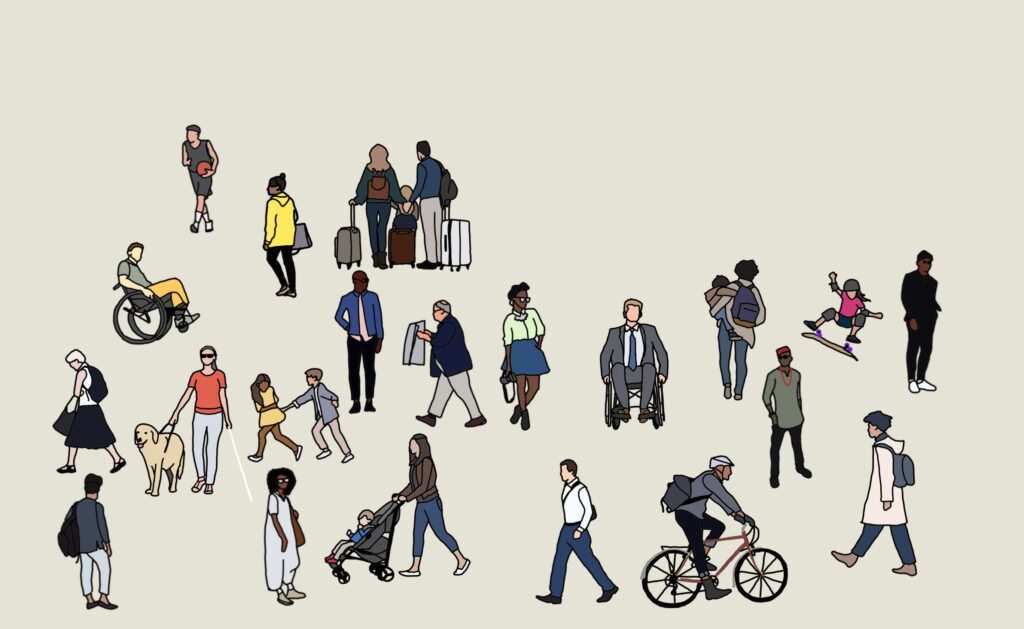
Americans with Disabilities Act (ADA) Turns 30
Elizabeth Claassen, AIA
July 26, 2020
Reflecting on 30 Years
On July 26, 1990, the Americans with Disabilities Act was signed into law by President George H.W. Bush. This ground-breaking legislation helped transform society and the built environment into one that is more inclusive and barrier-free for all. As architects, we commemorate this anniversary by reflecting upon the impact ADA has had on the built environment over the last 30 years, analyzing the barriers that still exist, and recommitting ourselves to the work of inclusion in design.
The passing of the ADA in 1990 started in the 1970’s and 1980’s with peaceful protests and sit-ins in San Francisco and Washington DC, which led to several precursors to the ADA such as Section 504 of the Rehabilitation Act of 1973, and the Fair Housing Amendments Act of 1988.
The ADA is a civil rights law, not a building code or standard. As architects and designers, we can spend all of our time pouring over floor plans and details, reducing ADA guidelines to a series of mounting height dimensions and floor clearance boxes, which can serve to de-humanize the intention of the ADA, and the individuals that it serves. Are we tacking on layers in order to satisfy minimum requirements, or are we designing public spaces with the true intent of inclusion for all?
Inclusive Design
The spirit and goal of the legislation is to create equal access for all to the built environment. Limitations go beyond mobility, and inclusive design should as well. Design should consider varying abilities of mobility, hearing, sight, cognition, and mental health.
Minimum requirements allow separate but equal access to the built environment. But separate is still not equal. If inclusion is part of the design process from the onset, the resulting built environment will become a better space for everyone. If your space is accessible and welcoming to wheelchair users, it also functions better for individual pushing strollers or shopping carts, wheeling suitcases, riding bicycles, and for children. If your design incorporates wayfinding for those with limited sight, chances are it will benefit sighted individuals and those with varying cognitive abilities as well, resulting in all people navigating the space more easily.
Retrofitting the Pre-1990 Built Environment
Retrofitting existing spaces to meet inclusive standards can be a challenge. But it is also an opportunity to think creatively and implement the problem-solving skills that architects possess.
As architects in NYC, we are surrounded by a high-density built environment, constructed mostly before accessibility legislation. One need not look much further than the NYC Subway system to see how far we have to go to make our city truly inclusive. With approximately one million New Yorkers identifying as living with a disability, it is important for architects and designers to change our perspective of ADA as an obligation, and to reframe it as an opportunity.
Goshow Architects has a strong history of commitment to inclusiveness and to designing for everyone. We have an equally strong commitment to the preservation of the extraordinary public buildings that have served our citizens for decades, but which have not been designed with everyone in mind. It is at the confluence of these two areas of our architectural belief and commitment – preserving our built heritage and making it truly accessible to all – that our practice has been widely recognized, for we have had the privilege of providing accessibility audits and renovations for some of New York’s most prestigious and iconic public buildings, such as:
- Grand Central Station
- The New York Public Library, Main Branch
- The Frick Collection
- Lincoln Center for the Performing Arts
- The Seagram’s Building and The Four Seasons’ Restaurant
- The Fifth Avenue Presbyterian Church
Current Climate
The unparalleled growth of technology since the passage of the ADA, coupled with a rapid cultural increase in reliance on technology over the last few months due to the pandemic, has exposed the shortcomings of accessibility in the digital world. In this time, we have watched as many public events went virtual, but struggled to include captioning or sign-language interpreters. Many video conferencing services, while making great strides in short amounts of time, have not focused on adaptability elements such as options for enlarging text or video panels. There are limited rules and regulations for technological accessibility, and even less enforcement.
The COVID-19 pandemic has also exposed disparities in risk for those with disabilities. Studies are beginning to show that COVID-19 disproportionately affects the disability community, due to unequal access to healthcare and greater prevalence of pre-existing conditions.
While it is easy to focus on the negatives of the current climate, we can also find inspiration in learning about the creation of the Americans with Disabilities Act. The individuals who participated in peaceful protests in their pursuit of equality were inspired by the civil right movement of the 1960’s. Similarly, this generation, fighting for marriage equality, affordable health care, and racial equality can be inspired by the impact that can come from peaceful protest against discrimination.
Helpful Links and Further Reading
https://www.ada.gov/30th_anniversary/index.html
https://www.nytimes.com/interactive/2020/us/disability-ADA-30-anniversary.html
https://www1.nyc.gov/assets/ddc/downloads/publications/guides-manuals/universal-design-ny.pdf
https://www1.nyc.gov/site/mopd/initiatives/inclusive-design-guidelines.page
